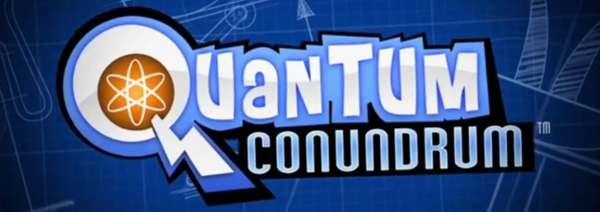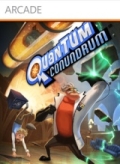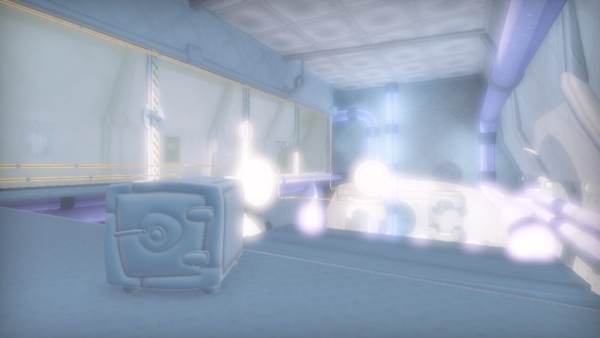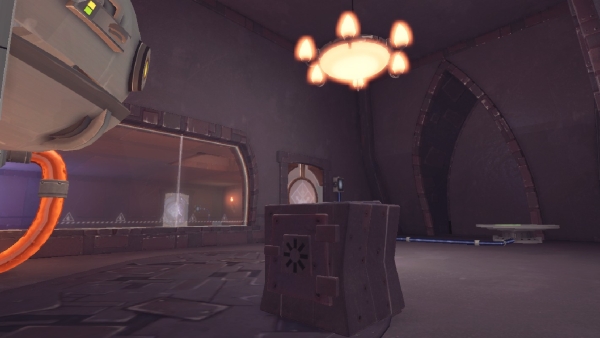
There are some heavy expectations when your name is preceded by the informal title of “Portal co-creator,” but Kim Swift has proven she can handle the pressure. Her new game, Quantum Conundrum, is a fun brain-twisting puzzler reminiscent of her more famous previous work. However, a few significant issues keep it from achieving GLaDOS-level heights.
Platforms: PC, PS3, Xbox 360 (Version Played)
Publisher: Square Enix
Developer: Airtight Games
Genre: Portalless Platforming Puzzler
Release Date: June 21, 2012 (PC), July 10, 2012 (PSN), July 11, 2012 (XBLA)
ESRB Rating: Everyone
 You play as a silent protagonist using a physics-bending experimental device to solve puzzles and work your way through a giant research facility, all while a disembodied voice comments on your progress. Sound familiar? The game feels almost exactly the same as Portal, only this time, you play as the 12-year-old nephew of the eccentric Professor Quadwrangle (voiced by John de Lancie – yes, Star Trek’s omnipotent Q, which somehow seems appropriate) as you visit his massive mansion-turned-laboratory. As soon as you arrive, something goes wrong with one of his experiments, and you are tasked with solving the mystery by navigating through puzzles in each room.
You play as a silent protagonist using a physics-bending experimental device to solve puzzles and work your way through a giant research facility, all while a disembodied voice comments on your progress. Sound familiar? The game feels almost exactly the same as Portal, only this time, you play as the 12-year-old nephew of the eccentric Professor Quadwrangle (voiced by John de Lancie – yes, Star Trek’s omnipotent Q, which somehow seems appropriate) as you visit his massive mansion-turned-laboratory. As soon as you arrive, something goes wrong with one of his experiments, and you are tasked with solving the mystery by navigating through puzzles in each room.
To help you along the way, you are given a Portal gun – er, an Inter-Dimensional Shift (IDS) device, a special glove that can shift the room into alternate dimensions. The Fluffy dimension changes everything into soft plush, which allows you to pick up and throw normally unmovable objects like furniture and safes. There is also Heavy, which turns things into dense, rusty iron; Slow-Mo, which slows time to a crawl; and Reverse Gravity, which sends unsecured objects falling upwards towards the ceiling. Your interaction with these dimensions and objects is how you solve the puzzles.
You can only use one dimension at a time, and are often limited in your selection based on the type of batteries you find (each dimension requires an appropriate battery, a clever way of imposing restrictions on what you can use in each room). The difficulty ramps up slowly at first, gently introducing you to the dimension-shifting mechanics. However, you will soon be wracking your brain as you are rapidly switching between several dimensions while desperately trying to avoid death.
Yes, you will die – a lot. It seems like your crazy uncle has a massive plumbing problem, with many rooms flooded with toxic science juice (yes, that’s the official name for it – after all, what mad scientist doesn’t need some glowing, technologically wondrous mystery fluid to fuel his experiments?). Since the game relies heavily on platform jumping, you want to avoid taking a swim wherever possible.

However, the inherent disadvantages of first-person platforming notwithstanding (namely, accurately judging how close you are to the edge), the big problem is that the game suffers from twitchy, overly sensitive controls. Even with the sensitivity dialed down, you will often suddenly surge forward when you only meant to make a tiny adjustment, which can cause a frustrating amount of accidental deaths. Given the ridiculous amount of times you have to pick up an object (using Fluffy), throw it over a chasm (while quickly hitting Slow-Mo), jump on it, and then jump onto another object, having smooth, accurate controls is a must. As it stands, you will quickly learn to dread any jumping sections, of which there are plenty.
This is a shame, because the puzzles are generally clever and well designed. From navigating deadly chasms to manipulating a safe through an obstacle course, your brain (and dimension-shifting fingers) will get a fun workout. Like Portal, you will sometimes get stuck for a while, but eventually, you’ll earn the highly satisfying “a-ha!” moment of figuring it out. Things can get pretty intense when you have to do numerous dimension shifts in rapid, precisely timed succession, but a generous checkpoint system means you can take baby steps without having to replay huge portions of the level. In fact, it’s this checkpoint system that helps take some of the pain out of the platforming sections.
Graphically, the environment has a cool cartoony art style that fits well with the overall theme of the game. The puzzle rooms are huge and look very impressive, but the needlessly long hallways connecting them are empty, drab and recycled over and over. However, of special note is how the world changes depending on what dimension you’re in: hit Fluffy and everything turns white and plush, while Heavy turns everything rusty and riveted. Even the artwork on the wall changes, sometimes with hilarious results.
Speaking of hilarious, the DOLLI object creation machines will have you giggling each time you see them. These are giant Pac Man-looking wall-mounted machines that literally vomit out safes and furniture, complete with a comical mechanical retching sound. They’re so silly that even in my most frustrated moments, I could look at a DOLLI and still crack a smile.

The story is supposed to be focused on this sense of humor, yet disappointingly, it’s not that funny. You can’t blame John de Lancie – after all, he’s only reading what’s been written for him, which is pretty hit or miss. I suppose the writers played it safe to keep the E for Everyone rating, but you can still play it safe and generate laughs. Add an unsatisfying explanation to the mystery with a very abrupt ending, and you have a very forgettable and unremarkable story.
The ending does set up a sequel which, despite the game’s flaws, I hope they consider making. Fixing the twitchy controls would go a long way towards improving the experience, as well as relying less on platforming. Some of the best levels involve manipulating objects solely by flipping between dimensions – no jumping required – so more of these would be welcome. The writing needs improvement as well.
Also, more work is needed to prevent game-breaking situations, like doing something out of the pre-programmed order. For example, there have been times when I’ve gone somewhere or grabbed a dimensional battery out of the “proper” sequence of events, which prevents the game from activating the next process in the sequence, leaving you stuck. This means you have to restart the level, which can be frustrating if you’ve just completed a particularly difficult section.
But overall, Quantum Conundrum is worth your money if you are a fan of Portal or puzzle games in general. It doesn’t capture the magic or fun hilarity of Portal, and the twitchy controls can be frustrating in the platforming sections, but the clever puzzles and unique dimension-shifting mechanics will keep you well entertained. Leaderboards for completing puzzles in the shortest amount of time and in the least number of shifts also add replayability and bragging rights. One funny note: completing all levels without dying earns you an Achievement called “Still Alive” – but unfortunately, you still don’t get cake.

Review Disclosure: A review copy of Quantum Conundrum was provided by Sqaure Enix for the purposes of this review.







